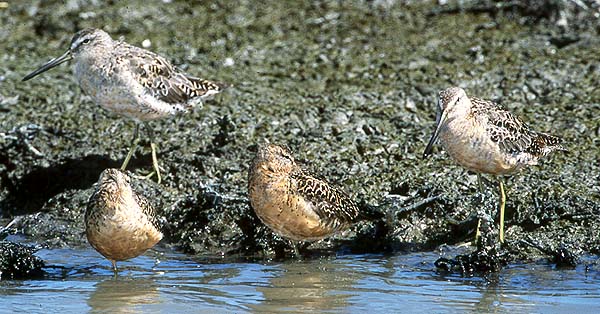
All rights reserved.
I agree that molting adult dowitchers present one of the more intractable identification issues and I hoped that this month's mystery would shed some light on the problem. I presented this, and other dowitcher photographs at the Western Field Ornithologist's Annual Meeting in Reno as part of the Identification Panel discussion. The panel was divided on the identification of several of the photos with some reasonably clear images disputed by the experts.
Identification of dowitchers by plumage rests on correctly aging the birds. If they are in juvenal plumage, the identification is relatively straightforward. Then the upperpart feathering, particularly the tertials and scapulars, are more heavily marked with internal marbling on Short-billed. If the birds are adults in breeding plumage, the pattern of the underparts is more important. Then Long-billed have more extensive salmon coloration on the underparts, and more extensive barring on the sides of the breast. If the birds are adults in winter plumage, they are usually indistinguishable except by voice.
Molting adults, such as these, are difficult because the characters normally visible in full breeding (alternate) plumage may be mixed with ambiguous winter (basic) plumage. Several interesting points were raised in the panel discussion in Reno. Jon Dunn pointed out that basic plumage Short-billed Dowitchers sometimes show distinct spotting on the upper breast, which is not present on Long-billed Dowitchers. Jon also suggested that Long-billed Dowitchers appear to stop in the middle of the autumn migration to complete their molt, while Short-billed Dowitchers migrate non-stop and complete molting on their wintering grounds. Thus molting dowitchers in areas where Short-billed is not known to winter should be Long-billed. Steve Howell mentioned that Short-billed Dowitchers' bill shape tends to bend uniformly downward in the middle, while Long-billed sometimes bends slightly upward in the middle and then curves gradually downward. Steve also pointed out that the legs of Long-billed Dowitchers are proportionately longer than Short-billed, and the feet project noticeably beyond the tail in flight. Al Jaramillo has suggested that the west coast race of Short-billed Dowitcher may average a longer primary projection beyond the folded tertials than Long-billed.
With regard to these mystery birds, I think the extensive salmon coloration on the underparts of the middle bird is outside the range of Short-billed and strongly suggestive of Long-billed. Panel participants pointed out the relatively long legs of the right-hand bird as favoring Long-billed. The bill shape of the back-left bird seems to be subtly better for Long-billed to me although its legs seem a bit short. It appears to lack any visible primary projection, which might be expected on Short-billed. I believe it is also probably a Long-billed. This is a locality where Short-billed may be found in winter, but where Long-billed is more common.
 |
Photo © Peter LaTourrette All rights reserved. |